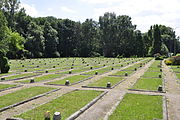Soviet military cemetery in Warsaw
The Soviet Military Cemetery in Warsaw ( Cmentarz Mauzoleum Żołnierzy Radzieckich ) is one of the largest Soviet military cemeteries in Poland. 21,668 Soviet officers and soldiers who died in the battle for Warsaw in 1944 and 1945 are buried here. The cemetery is defined by an obelisk -shaped memorial , is located on the multi-lane Ż Wirki-i-Wigury Street, which connects downtown Warsaw with the Frédéric Chopin Airport and belongs to the Mokotów district .
history
The Polish name Cmentarz Mauzoleum Żołnierzy Radzieckich refers to the Soviet army, which only existed under this name from 1946, the fallen soldiers were members of the Red Army at the time of their death .

Construction work on the complex began in 1949 and the facility was inaugurated on May 9, 1950. The soldiers' remains had been exhumed in various local cemeteries , cremated and taken to the new memorial site. The fallen soldiers buried here belonged to the following units of the Soviet Union 1st Belarusian Front :
- 8th Guard Army
- 28th , 47th , 48th , 65th , 69th and 70th Army
- 2nd Guard Panzer Army
- 6th and 16th Air Force
- XXXXVI. Rifle Corps
- II. And VII. Cavalry Corps
- I. Guard Panzer Corps
As a result of Russia's participation in the crash of the Polish presidential plane in Smolensk on April 10, 2010, Polish artists and celebrities urged the Warsaw population to pick up the fallen Red Army soldier on May 9, 2010 (65th anniversary of the end of the Second World War - Victory Day ) to pay tribute to the cemetery.
architecture
Starting from a parking lot on Ż Wirki-i-Wigury-Straße, the entire facility extends to the east. It covers an area of almost 200,000 square meters. The center is a 38-meter-tall obelisk raised on three terraces. The inscription on the obelisk reads:
" To the eternal glory of the heroic soldiers of the invincible Soviet Army who were killed fighting the fascist invaders and for the liberation of our Polish capital of Warsaw
(Ku wiecznej chwale bohaterskich Żołnierzy niezwyciężonej Armii radzieckiej, poległych w bojach for hitlerowskim najeźdźcą o Wyzwolenie Polski i naszej stolicy Warszawy) "
To the left and right of the avenue-like entrance to this monument are initially two monumental pedestals, the frontal side views of which show depictions of workers and other civilians greeting victorious soldiers. Next to these representations there are Polish (right) and Russian (left) inscriptions for the purpose of the cemetery.
There are 294 named grave sites in three rows each. Between one and three officers per grave site were buried here. On the outside staircase to the obelisk there are two more monumental plinths on which the memorial scenes "Heroism" ( Bohaterstwo ) and "Sacrifice" ( Ofiarność ) are depicted.
The soldiers' mass graves stretch north and south of the memorial. At some of the 540 numbered grave sites, relatives put up small memorial plaques. The memorial and cemetery are surrounded by a tree-lined park landscape, which is followed by allotment gardens.
The design of the facility was based on the winning design of a tender among students of the Academy of Fine Arts in Warsaw. The architecture follows the monumental-realistic style of socialist show buildings of the time. Consisting of granite designed Obelisk and the necropolis were of Bohdan Lachert and Władysław Niemirski created. The heroes' memorials come from the sculptors Jerzy Jarnuszkiewicz ("Heroism") and Stanisław Lisowski ("Sacrifice"). The park landscape concept was designed by Irma Ignaczak.
Components of the cemetery
Web links
- Satellite image on Google Maps / Earth
- Detailed photos of the monuments and base figures
References and comments
- ↑ In Poland, around 1.3 million Russian and Soviet soldiers and prisoners from the First and Second World Wars are buried in 638 cemeteries
- ↑ according to 1950 , No. 73, in: Krzysztof Jabłonski, Warszawa. Potret Miasta , Arkady, Warszawa 1984
- ↑ among others Agnieszka Holland , Krystyna Janda , Andrzej Wajda , Wisława Szymborska , Adam Michnik , and Józef Życiński
- ↑ according to Article 9 maja zapłoną znicze na cmentarzach żołnierzy radzieckich at Wirtualnapolska.pl
- ↑ Władysław Niemirski (1914-2001)
- ↑ Jerzy Jarnuszkiewicz (1919–2005) was a Polish sculptor who created, among other things, the “ Monument to the Little Insurgent ” ( Pomnik Małego Powstańca ) on the Warsaw city wall
Coordinates: 52 ° 12 ′ 9 ″ N , 20 ° 59 ′ 12 ″ E




